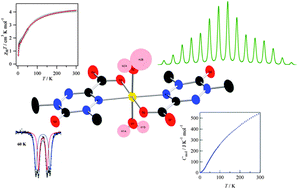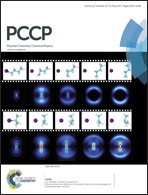A tricky water molecule coordinated to a verdazyl radical–iron(ii) complex: a multitechnique approach†
Abstract
The first iron complexes of high-spin iron(II) species directly coordinated to verdazyl radicals, [FeII(vdCOO)2(H2O)2]·2H2O (1; vdCOO− = 1,5-dimethyl-6-oxo-verdazyl-3-carboxylate) and [FeII(vdCOO)2(D2O)2]·2D2O (2), were synthesized. The crystal structure of 1 was investigated by single-crystal X-ray diffraction at room temperature and at 90 K. The compound crystallizes in the P![[1 with combining macron]](https://www.rsc.org/images/entities/char_0031_0304.gif) space group with no phase transition between 300 and 90 K. The crystals are composed of discrete [FeII(vdCOO)2(H2O)2] complexes and crystallization water molecules. In the complex, two vdCOO− ligands coordinate to the iron(II) ion in a head-to-tail arrangement and two water molecules complete the coordination sphere. The Fe–X (X = O, N) distances vary in the 2.069–2.213 Å range at 300 K and in the 2.0679–2.2111 Å range at 90 K, indicating that the iron(II) ion is in its high-spin (HS) state at both temperatures. At 300 K, one of the coordinated water molecules is H-bonded to two crystallization water molecules whereas the second one appears as loosely H-bonded to the two oxygen atoms of the carboxylate group of two neighboring complexes. At 90 K, the former H-bonds remain essentially the same whereas the second coordinated water molecule reveals a complicated behavior appearing simultaneously as tightly H-bonded to two oxygen atoms and non-H-bonded. The 57Fe Mössbauer spectra, recorded between 300 K and 10 K, give a clue to this situation. They show two sets of doublets typical of HS iron(II) species whose intensity ratio varies smoothly with temperature. It demonstrates the existence of an equilibrium between the high temperature and low temperature forms of the compounds. The solid-state magic angle spinning 2H NMR spectra of 2 were recorded between 310 K and 193 K. The spectra suggest the existence of a strongly temperature-dependent motion of one of the coordinated water molecules in the whole temperature range. Variable-temperature magnetic susceptibility measurements indicate an antiferromagnetic interaction (JFe–vd = −27.1 cm−1; H = −JijSiSj) of the HS iron(II) ion and the radical spins with high gFe and DFe values (gFe = 2.25, DFe = +3.37 cm−1) for the HS iron(II) ion. Moreover, the radicals are strongly antiferromagnetically coupled through the iron(II) center (Jvd–vd = −42.8 cm−1). These last results are analysed based on the framework of the magnetic orbitals formalism.
space group with no phase transition between 300 and 90 K. The crystals are composed of discrete [FeII(vdCOO)2(H2O)2] complexes and crystallization water molecules. In the complex, two vdCOO− ligands coordinate to the iron(II) ion in a head-to-tail arrangement and two water molecules complete the coordination sphere. The Fe–X (X = O, N) distances vary in the 2.069–2.213 Å range at 300 K and in the 2.0679–2.2111 Å range at 90 K, indicating that the iron(II) ion is in its high-spin (HS) state at both temperatures. At 300 K, one of the coordinated water molecules is H-bonded to two crystallization water molecules whereas the second one appears as loosely H-bonded to the two oxygen atoms of the carboxylate group of two neighboring complexes. At 90 K, the former H-bonds remain essentially the same whereas the second coordinated water molecule reveals a complicated behavior appearing simultaneously as tightly H-bonded to two oxygen atoms and non-H-bonded. The 57Fe Mössbauer spectra, recorded between 300 K and 10 K, give a clue to this situation. They show two sets of doublets typical of HS iron(II) species whose intensity ratio varies smoothly with temperature. It demonstrates the existence of an equilibrium between the high temperature and low temperature forms of the compounds. The solid-state magic angle spinning 2H NMR spectra of 2 were recorded between 310 K and 193 K. The spectra suggest the existence of a strongly temperature-dependent motion of one of the coordinated water molecules in the whole temperature range. Variable-temperature magnetic susceptibility measurements indicate an antiferromagnetic interaction (JFe–vd = −27.1 cm−1; H = −JijSiSj) of the HS iron(II) ion and the radical spins with high gFe and DFe values (gFe = 2.25, DFe = +3.37 cm−1) for the HS iron(II) ion. Moreover, the radicals are strongly antiferromagnetically coupled through the iron(II) center (Jvd–vd = −42.8 cm−1). These last results are analysed based on the framework of the magnetic orbitals formalism.


 Please wait while we load your content...
Please wait while we load your content...